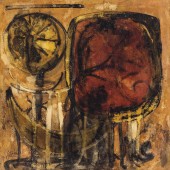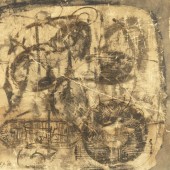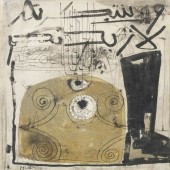Ahmad Shibrain
- Country: Sudan
- Exhibitions:
- A Century in Flux
- Taking Shape
- The Short Century
Working primarily as a painter and graphic artist, Ahmed Shibrain is a leading figure of modernism in Sudan. Alongside his influential contemporaries Ibrahim El-Salahi and Kamala Ishag, Shibrain was one of the founders of The Khartoum School in the 1960s, a movement of artists who cultivated a new visual style called Sudanawiyya, which expressed local and Pan-African traditions alongside Western influences. Through the use of calligraphy, the aesthetics of hurufiyya (transforming Arabic letters into abstract shapes; named after harf the Arabic word for letter) and Islamic motifs, the movement attempted to convey the cultural fabric of the Sudan. In the early 1950s, Shibrain studied at Khartoum’s College of Fine and Applied Art for two years and was a student of London’s Central School of Arts in 1957. After returning to Khartoum, Shibrain became the head of the graphics department at his former college in 1970, and its dean in 1975. In 1996 he also founded the Shibrain Art Centre, which showcases Sudanese artists.
يظل أحمد شبرين، الذي يعمل بشكل أساسي كرسام ومصمم غرافيكي، شخصية قيادية بارزة في الحداثة في السودان. وكان شبرين، إلى جانب معاصرَيه المؤثرين الفنان إبراهيم الصلحي والفنانة كمالا إسحق، من مؤسسي \"مدرسة الخرطوم\" في الستينيات؛ وهي حركة لمجموعة من الفنانين الذين طوروا أسلوبا ًبصرياً جديداً يدعى \"السودانوية\" ويعبر عن التقاليد المحلية والإفريقية إلى جانب التأثيرات الغربية. ومن خلال استخدام فن الخط وجماليات الحروفية (تحويل الحروف العربية إلى أشكال مجردة) والزخارف الإسلامية، حاولت هذه الحركة نقل النسيج الثقافي السوداني. ودرس شبرين في بداية الخمسينيات في كلية الفنون الجميلة والتطبيقية في الخرطوم لمدة سنتين، ثم التحق بالمدرسة المركزية للفنون في لندن عام 1957. وبعد عودته إلى الخرطوم، أصبح شبرين رئيس قسم التصميم في كليته السابقة عام 1970، وعميدها بدءاً من عام 1975. وأسس أيضاً عام 1996 \"مركز شبرين للفنون\" الذي يقيم المعارض للفنانين السودانيين.






